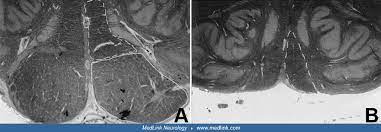L1 syndrome describes a group of conditions that primarily affect the nervous system and occur almost exclusively in men. These conditions vary in severity and include, from most to least severe, X-linked hydrocephalus with stenosis of the Sylvian aqueduct (HSAS), MASA syndrome, spastic paraplegia type 1, and complicated X-linked agenesis of the corpus callosum.
HSAS is an acronym for the characteristic features of the condition: a buildup of fluid in the brain (hydrocephalus) that is often present since before birth, muscle stiffness (spasticity), thumbs that are permanently bent toward the palms (thumbs adducted) and narrowing (stenosis) of a passageway in the brain called the Sylvian aqueduct. In people with HSAS, stenosis of the aqueduct of Sylvius causes hydrocephalus by preventing the flow of cerebrospinal fluid (CSF) out of fluid-filled chambers called ventricles. People with HSAS often have severe intellectual disability and may have seizures.
MASA syndrome is also named for the characteristic features of the condition, which are mild to moderate intellectual disability (mental retardation), delayed speech (aphasia), spasticity, and adducted thumbs. People with MASA syndrome may have mild enlargement of the ventricles.

Spastic paraplegia type 1 is characterized by progressive muscle stiffness (spasticity) and the development of limb paralysis (paraplegia). Affected individuals also have mild to moderate intellectual disability. People with type 1 spastic paraplegia do not usually have major abnormalities in the structures of the brain.
Complicated X-linked corpus callosum agenesis is defined by the underdevelopment (hypoplasia) or absence (agenesis) of the tissue that connects the left and right halves of the brain (the corpus callosum). People with this condition may have spastic paraplegia and mild to moderate intellectual disability.
The life expectancy of people with L1 syndrome varies depending on the severity of the signs and symptoms. Severely affected individuals may survive for a short time after birth, while those with mild traits live into adulthood.
The conditions that make up L1 syndrome were once thought to be distinct disorders, but since they were found to share a genetic cause, they are now considered part of the same syndrome. Family members with L1 syndrome caused by the same mutation may have different forms of the condition.